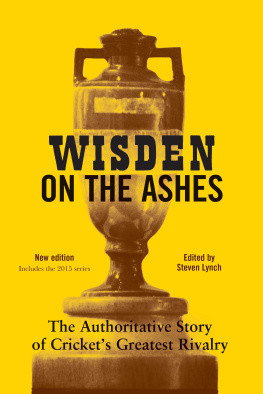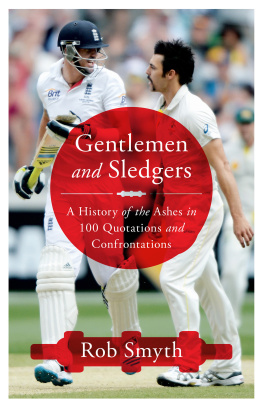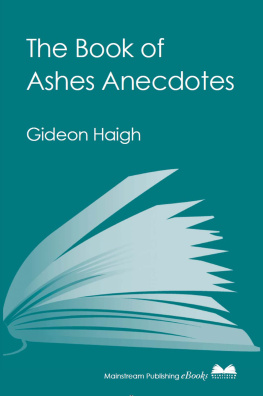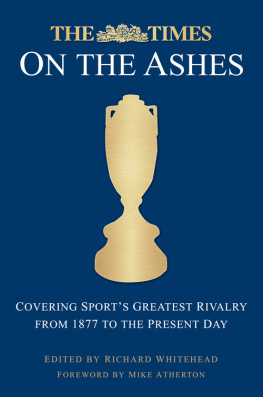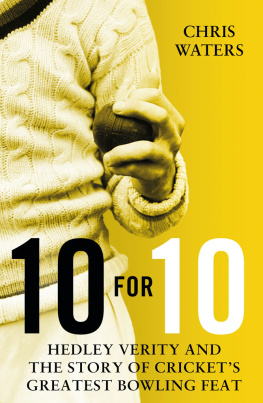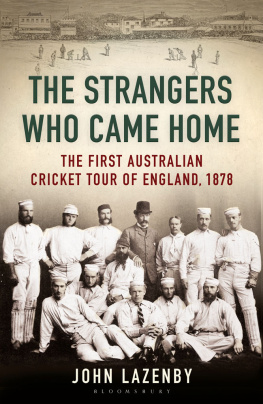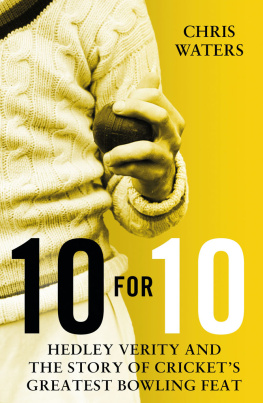WISDEN
ON THE ASHES
WISDEN
ON THE ASHES
Updated to include the 2015 series

THE AUTHORITATIVE STORY OF CRICKETS GREATEST RIVALRY
EDITED BY
Steven Lynch
FOREWORD BY
Sir Alec Bedser
Contents
Acknowledgments
Remember that any book always involves about twice as much work as you first think, Matthew Engel, the former Wisden editor, told me when I agreed to try to condense the story of 341 EnglandAustralia Test matches into one volume of reasonably sensible length. His wise words hit home forcibly about halfway through the task, as another 10,000-word tour review loomed out of the sepia pages of history. But, by wielding the computer equivalent of the red pen with Zorro-like abandon (and largely ignoring my father Brian, visiting from Australia, for which I apologise), Wisdens story of the Ashes did eventually fit between these reassuringly yellow covers. That it does so owes much to my colleagues Christopher Lane, Lawrence Booth, Hugh Chevallier and Harriet Monkhouse of Wisden, not least for tolerating my temporary absence from an even smaller and fatter yellow book; to Charlotte Atyeo and Holly Jarrald of Bloomsbury, and their design team; the typesetters at Deanta; and, last but certainly not least, my partner Inese, who put up with my rare appearances outside the office and still supplied tea and cake, while my sons Daniel and Mark also tried to help, in between trying to eat the cake. Thanks are also due to the many Wisden contributors over the years whose work is reprinted here, and to Sir Alec Bedser for providing such a thoughtful Foreword. Perhaps the biggest round of applause, though, should go to the successive generations of English and Australian cricketers who have made the Ashes what they are the most famous rivalry in international sport.
Most of the illustrations are from Getty Images, with some from the editors private collection. The photograph of the Hon. Ivo Bligh was kindly provided by his great-grandson, Rupert Peploe. The Records section was compiled by Philip Bailey.
STEVEN LYNCH
Dates to the right of the headings often following the name of the writer when shown refer to the edition of Wisden in which the extract first appeared. For example, the 2013 Ashes series was covered in Wisden 2014.
The match reports for the 2015 series were specially written for this book, which was published before the 2016 edition of Wisden.

Alec Bedser: 104 wickets in 21 Ashes Tests.
Sir Alec Bedser played in five Ashes series, playing 21 Tests and taking 104 Australian wickets. He is the only English bowler to have taken 30 or more wickets in Ashes series at home and away. After retiring as a player, he was an England selector for 13 Ashes series (plus one in which the Ashes were not at stake, and the two one-off Centenary Tests). He was also the manager for the 197475 and 197980 tours of Australia, after being the assistant manager in 196263. Sir Alec died in April 2010, aged 91, 16 months after writing this foreword.
It is a great pleasure to be asked to write this foreword, as I have had a long association with both the Ashes and Wisden. Indeed the Ashes has been a significant factor throughout much of my life, while Wisden has recorded and reported on my entire cricket career.
One of the greatest honours in my career was being selected as one of Wisdens Five Cricketers of the Year in 1947. In 2007, at the dinner to launch that years Wisden, I was honoured to be presented with a special leatherbound copy of the 1947 almanack to mark the 60th anniversary of my being named. As I write this foreword, my great friend and ex-Surrey and England colleague Arthur McIntyre, who was born less than two months before me in 1918, is the only Wisden Cricketer of the Year still alive who is older than me.
I think my earliest Ashes-related memory is seeing the Evening News when Don Bradman scored 334 at Headingley in 1930. It was unusual to have big photos in the papers in those days, let alone a cricket one, but I remember half of the front page was taken up by a photo of The Don. I had just had my 12th birthday the previous week, and seeing Bradman on the front page made a big impression on me.
Six years later I remember listening to bits of Alan McGilvrays radio commentaries of the 193637 Ashes series in Australia. By that time my twin brother Eric and I were set on a cricket career with Surrey, and like any young cricketer I wanted to play for England against Australia. When Australia toured in 1938 I was busy playing for Surreys Second Eleven, so I didnt get to see any of the Tests. However, I only just missed out, as we arrived back at The Oval at the end of a West Country tour just a few hours after the final Test finished. I remember looking at the pitch which, after four days play, was as perfect a strip as I ever saw. Hutton had made a world-record score of 364 and England had declared on 903 for 7. The groundsman, Bosser Martin, had predicted that they would get a thousand on his pitch so I remember him being upset that Wally Hammond had declared!
Eric and I made our Surrey debuts in 1939, but our careers were almost immediately put on hold as we joined the RAF when war broke out. I played a little cricket in the early part of the war, including some matches at Lords against the Australian forces, who included the great and inimitable Keith Miller. But after serving in Italy and France I arrived back at The Oval for the beginning of the 1946 season having not played at all for two years. After only ten games I made my England debut against India at Lords. It was a dream start as I took 11 wickets in each of my first two Tests, and ended the season being selected for the winter tour of Australia.
I was one of only four men under the age of 30 on that tour, which we ended up losing 30. But other than the result, the whole thing was an amazing experience. We travelled there on Ministry of War transport the Stirling Castle troop ship. The voyage was particularly memorable because the passengers were made up of 17 England cricketers and some 600 war brides! But our trip home was even more special, because we returned by flying boat, stopping off at numerous exotic places such as Singapore (where we stayed at the famous Raffles Hotel) and Cairo (where we landed on the Nile).
At the end of that 194647 series I began a remarkable run of four Ashes Tests in which I dismissed Bradman six times. In the Fourth Test I managed to bowl him for nought, which I followed up by dismissing him again in the second innings of the last Test, and then again in both innings of the first two Tests in the 1948 series (including another duck). Although we rarely spoke to each other on those tours (he didnt socialise much in his playing days), we became very close friends later, and Eric and I visited Don and his wife Jessie in Adelaide on countless occasions during the next five decades.
In 1953 we had a very strong team which famously won back the Ashes 19 years after losing them. I took 39 wickets in the five-match series, and looking back I think my career high point was at Trent Bridge in the First Test when I had match figures of 14 for 99. My last England tour as a player was to Australia in 195455. Unfortunately I got shingles on the way out, which laid me low for the entire tour. I played in the First Test, but was below my best and it proved to be my last in the Ashes. So it was from various pavilions that I watched Frank Tyson terrorise the Aussies while we retained the Ashes. I played my last Test for England the following summer, and I finally retired from first-class cricket at end of the 1960 season; Eric followed me into retirement a year later.

